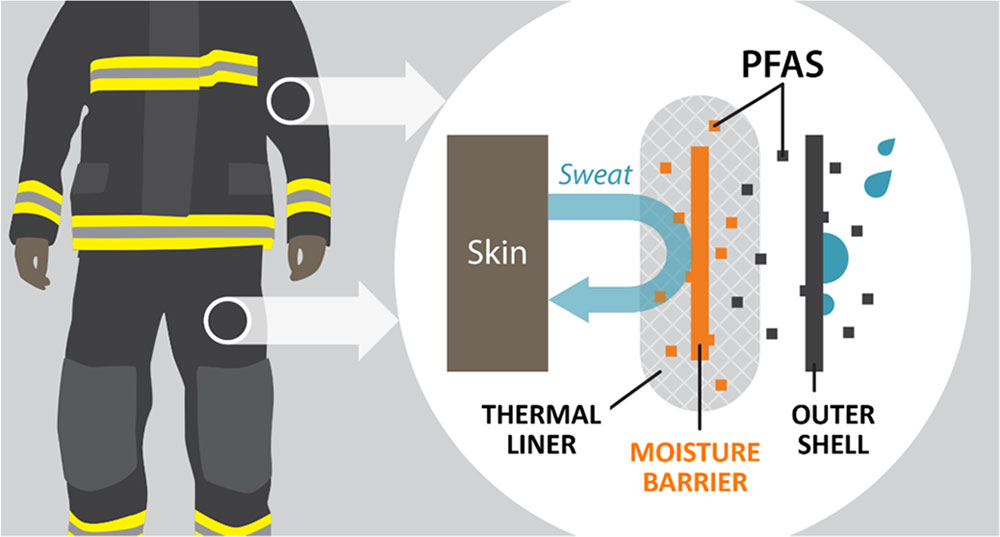Article originally published in The Responder, Fall/Winter 2021 edition
While it is well known that firefighters are at increased risk of certain types of cancer as a result of occupational exposure – much of the focus has been on the carcinogens in the smoke and not on the “forever chemicals” known as PFAS that have been a part of firefighting foam and coating their PPE for decades. As awareness for the issues around PFAS have moved to the forefront, the industry has been making progress to phasing these chemicals out.
What are PFAS and how are they used in Firefighting?
PFAS, which stands for per- and polyfluorinated substances, are a class of widely used chemicals. What is unique about these chemicals is how stable they are. The bond that forms between the carbon and fluorine atoms is one of the strongest bonds possible in organic chemistry1. The fact that they are hard to break down has made them extremely useful in a wide range of industries, including firefighting, as surfactants in foam, and in PPE fabrics for its ability to repel water.
The Dangers of PFAS
While initially, the strength of that bond was thought to be non-reactive with living tissue, it turns out that is not the case. They are bioaccumulative, which means they're absorbed by living organisms faster than the body can break them down and excrete them. It has been found PFAS can remain within humans and wildlife for years. Even though these substances do not occur naturally, certain PFAS have been detected in wildlife and humans around the globe2. In fact, a recent Health Canada biomonitoring study said 98.5 per cent of Canadians have PFAS in their blood3. And in connection to certain PFAS exposure, research has shown an increased risk of various types of cancer (including kidney, testicular, ovarian, and prostate) and adverse effects to the liver, birth weight, metabolism and the immune system.
Removing PFAS from Foams
In Canada, a major point source of PFAS contamination is the use of firefighting foams to extinguish fuel fires or in the conduct of firefighting training and testing activities4 which can leach into ground water. While firefighting foam was previously exempt from government restrictions, the Government of Canada has proposed further restriction by removing all current exemptions. In June 2019, Transport Canada allowed airports to use PFAS-free firefighting foam, and in 2021 the Canadian Airports Procurement Association (CAPA) announced their foam choice of BIOEX ECOPOL A for airports beginning the transition to fluorine free foams.
Many airports across Northern Europe and Australia have already transitioned away from foams containing PFAS and have found fluorine free foams (F3) to be effective on fires, while reducing environmental impact, and remediation & clean-up costs5. F3 foams like those from BIOEX or the made in Canada FireRein Eco-GelTM are compatible with existing proportioning equipment, making the transition easy.
Removing PFAS from PPE
Because of the documented adverse health effects of PFAS, the primary concern to date in the fire services has centered on repeated use and exposure to AFFF6. In 2020, a study by researchers from Notre Dame and Harvard, published in the peer-reviewed Journal of Exposure Science & Environmental Epidemiology, found an additional PFAS exposure source for firefighters: PFAS that are shed from their protective clothing.
Dust measured in storage areas suggests that PFAS is being shed from the turnout gear’s outer shell. The study also found used gear showed migration of PFAS into the untreated thermal liner. “If they touch the gear, it gets on their hands, and if they go fight a fire and they put the gear on and take it off and then go eat and don’t wash hands, it could transfer hand to mouth,” researcher Graham Peaslee, Ph.D., a professor of physics at the University of Notre Dame, said in a news release on the earlier study. “And if you’re sweating and you have sweat pores, could some of these chemicals come off on the thermal layer and get into the skin? The answer is probably.”7

A multi-threat air filtration system for the fire hall, such as TFT’s StationProtect, will help capture PFAS particles that have been shed. But to deal with the problem we need to go to the source. Earlier this year, gear manufacturers have started to come out with PFAS free finishes on turnout gear. The durable, water-repellant (DWR) finish is being phased into more of the outer shell options with Fire-Dex TECGEN71+, Safety Components PBI Max™ LP, PBI Max™ 7oz, and Armor AP™ fabrics already available.
In Summary
There are many inherent risks in firefighting, and your equipment should be protecting you, not adding to your health risks. These regulation and industry changes to reduce your exposure to PFAS are for the benefit and health of not only firefighters, but our communities, our water systems and the wider environment.
Further Reading:
1,4 'Forever chemicals' can have far-reaching consequences, need more regulation in Canada, scientists say
2,3 Canada Gazette, Part I, Volume 155, Number 17: GOVERNMENT NOTICES
5 Is the burst of the AFFF bubble a precursor to long tern environmental liabilities?
6 Another Pathway for Firefighter Exposure to Per- and Polyfluoroalkyl Substances: Firefighter Textiles, Environmental Science & Technology Letters
7 New Study Finds 99 percent of fluorine found in fire station dust came from unknown PFAS